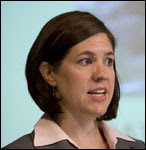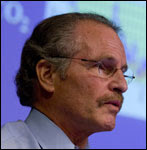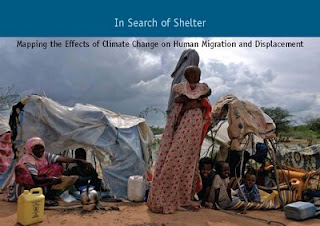-
Climate Disequilibrium Puts Human, Ecological Health at Risk
›July 14, 2009 // By Brian Klein The growing concentration of atmospheric carbon has punctured Earth’s climate equilibrium, said Dr. Paul Epstein, pushing the planet toward rapid transitions with serious implications for human and ecological health. Epstein, associate director of Harvard’s Center for Health and the Global Environment, spoke with Amanda Staudt, a climate scientist from the National Wildlife Federation, at an event hosted by the Woodrow Wilson Center’s Environmental Change and Security Program on June 16, 2009.
The growing concentration of atmospheric carbon has punctured Earth’s climate equilibrium, said Dr. Paul Epstein, pushing the planet toward rapid transitions with serious implications for human and ecological health. Epstein, associate director of Harvard’s Center for Health and the Global Environment, spoke with Amanda Staudt, a climate scientist from the National Wildlife Federation, at an event hosted by the Woodrow Wilson Center’s Environmental Change and Security Program on June 16, 2009.
Climate Change Is Accelerating Global warming appears to be advancing more quickly than predicted, Staudt cautioned, because “the developed world isn’t reducing their emissions as quickly as anticipated…there are more and more emissions from the developing world, and they’re increasing faster than expected…[and] some of our natural sinks are less efficient than what we had thought.” Epstein cited a 2000 NOAA study showing that “the oceans have warmed 20 times as much as has the atmosphere” over the past half-century, altering Earth’s hydrological cycle and thus accelerating climate change.
Global warming appears to be advancing more quickly than predicted, Staudt cautioned, because “the developed world isn’t reducing their emissions as quickly as anticipated…there are more and more emissions from the developing world, and they’re increasing faster than expected…[and] some of our natural sinks are less efficient than what we had thought.” Epstein cited a 2000 NOAA study showing that “the oceans have warmed 20 times as much as has the atmosphere” over the past half-century, altering Earth’s hydrological cycle and thus accelerating climate change.
No matter how drastically greenhouse gas emissions are cut, both experts warned, a litany of irreversible changes—including an increase in global average temperature and extreme weather events, desertification, sea-level rise, and species extinction—will continue.
Infectious Disease Increases A warming climate will increase the range of many diseases, Epstein explained. “The clearest signal we have in terms of infectious disease is in the mountains of Africa, Asia, and Latin America,” he said. “What we’re seeing in Kilimanjaro, in the Tibetan Plateau, in the Andes, is that glaciers are retreating, plant communities are upwardly migrating, and mosquitoes that cause malaria, dengue fever, and so on are circulating at higher altitudes” and latitudes further from the equator. For example, malaria has appeared in Nairobi, a mile-high city, and chikungunya fever—previously confined to Indian Ocean littoral states—induced panic and warranted a front-page New York Times article when several residents of a small Italian town contracted it in 2007.
A warming climate will increase the range of many diseases, Epstein explained. “The clearest signal we have in terms of infectious disease is in the mountains of Africa, Asia, and Latin America,” he said. “What we’re seeing in Kilimanjaro, in the Tibetan Plateau, in the Andes, is that glaciers are retreating, plant communities are upwardly migrating, and mosquitoes that cause malaria, dengue fever, and so on are circulating at higher altitudes” and latitudes further from the equator. For example, malaria has appeared in Nairobi, a mile-high city, and chikungunya fever—previously confined to Indian Ocean littoral states—induced panic and warranted a front-page New York Times article when several residents of a small Italian town contracted it in 2007.
Extreme weather events help diseases proliferate. Heavy rainfall drives sanitation into clean water supplies, spreading E. coli, cryptosporidium, and other waterborne pathogens. Drought, meanwhile, has facilitated meningitis epidemics in Africa’s Sahel region and the spread of disease-bearing mosquitoes that breed in buckets of water stored during periods of water scarcity.
Assault on Forests, Agriculture
Climate shifts have important consequences for the health of forests and agriculture. The “absence of killing frosts means that [mountain pine] beetles are overwintering, moving to higher altitudes, moving to higher latitudes, even getting in more generations each year,” Epstein said. Drought “dries the resin that drowns the beetles as they try to drive through the bark,” leaving pines trees in the Rocky Mountain Range vulnerable and posing acute economic and ecological challenges to dependent communities.
The higher frequency of droughts, floods, and heat waves, coupled with the spread of weeds, pests, and pathogens, could reduce agricultural production. In addition, studies have shown that many food crops (including cassava) contain higher levels of cyanide at earlier stages of growth as carbon concentrations rise, putting people who ingest them at risk.
Healthy Solutions to Climate Change
To address these challenges, several “stabilization wedges” with inherently healthy characteristics—forest conservation and restoration; agriculture reform; energy efficiency; and wind, solar, and geothermal power production—should be prioritized, Epstein advised. Other, less healthy options—including biofuels, nuclear power, and fossil fuel-based technologies—should undergo thorough lifecycle analyses before winning endorsement, he said.
The design and construction of healthy cities—“green roofs, green buildings, tree-lined streets, biking lanes, walking paths, open space, smart growth, public transport”—as well as a smart energy grid is an essential part of the solution, said Epstein. Countries should also move away from deregulation, privatization, and liberalization of the economy in favor of a system that contains sufficient regulation, public-private partnerships, and appropriate constraints.
“If we do this right,” Epstein concluded, “it can be good for public health, good for security, good for the economy, and we certainly hope it’ll stabilize the climate.”
Top Photo: Red, dying trees signal the spread of beetle infestations in the pine forests of Manning Park, British Columbia. Courtesy Flickr user Tim Gage.
Photos of Amanda Staudt and Dr. Paul Epstein courtesy Dave Hawxhurst and the Woodrow Wilson Center. -
Post-Conflict Recovery in Biodiversity Hotspots
› The prevalence of armed conflict in areas of high biodiversity is alarming, though not entirely surprising. According to “Warfare in Biodiversity Hotspots” (abstract online), which was published earlier this year in Conservation Biology, 80 percent of the major armed conflicts between 1950 and 2000 took place in biodiversity hotspots. While natural resources are rarely the principal causes of conflict, their allocation and ownership are frequently among its drivers.
The prevalence of armed conflict in areas of high biodiversity is alarming, though not entirely surprising. According to “Warfare in Biodiversity Hotspots” (abstract online), which was published earlier this year in Conservation Biology, 80 percent of the major armed conflicts between 1950 and 2000 took place in biodiversity hotspots. While natural resources are rarely the principal causes of conflict, their allocation and ownership are frequently among its drivers. -
VIDEO: Neil Adger on Adapting to Climate Change
›July 9, 2009 // By Sean Peoples“We can adapt to climate change… and there are lots of opportunities for change, lots of things that would be harmonious with sustainable development,” said Neil Adger, a professor at the University of East Anglia and leading researcher on adaptation at the Tyndall Centre for Climate Change Research in the UK. “But saying we can change and can adapt does not mean to say we necessarily will adapt to climate change.”
In this short video, ECSP Director Geoff Dabelko speaks with Adger outside the Global Environmental Change and Human Security conference in Oslo, Norway. As an environmental economist, Adger believes the need to mitigate and adapt to current and future climate shifts is unambiguous. Adger recently co-edited a new book with colleagues Irene Lorenzoni and Karen O’Brien, entitled Adapting to Climate Change: Thresholds, Values, Governance, in which they present the latest interdisciplinary research on adaptation.
Adger warns against relying on geo-engineering, or rearranging Earth’s atmospheric dynamics, as a “get-out-of-jail-free card.” He says “there are significant inherent dangers with just about every serious geo-engineering technology being discussed.”
For more information regarding geo-engineering, read The Climate Engineers, an essay by former Woodrow Wilson Center Public Policy Scholar James Fleming, which discusses the evolution of radical ideas to control atmospheric patterns. -
Climate Change Threatens Water Supplies in Australia, California
›July 1, 2009 // By Brian Klein Climate change “could be the straw that breaks the camel’s back” for California’s precarious water system, said W. Michael Hanemann of the University of California, Berkeley, at an event hosted by the Wilson Center’s Environmental Change and Security Program on June 15, 2009. He was joined by Jon Barnett of the University of Melbourne, who discussed some of Australia’s policy responses to its increasingly dry, variable climate.
Climate change “could be the straw that breaks the camel’s back” for California’s precarious water system, said W. Michael Hanemann of the University of California, Berkeley, at an event hosted by the Wilson Center’s Environmental Change and Security Program on June 15, 2009. He was joined by Jon Barnett of the University of Melbourne, who discussed some of Australia’s policy responses to its increasingly dry, variable climate. -
VIDEO: Dan Smith on Climate Change, Development, and Peacebuilding
›July 1, 2009 // By Wilson Center StaffClimate change will have serious impacts on fragile states. To effectively address the potential for instability, the climate community must communicate and collaborate with the development and peacebuilding communities.
In an interview recorded in Washington, Dan Smith of International Alert makes the case for extending this dialogue: “This is not just an environmental issue, not just a development issue, it’s not just a peace and conflict issue, if we don’t understand the connectivity and the interactions between all of these categories, we’re going to get it wrong.”
Smith enumerates the shortcoming of failing to account for the special circumstances of states in conflict or emerging from conflict by “Adaptation and peacebulding are very, very closely related. A society which can adapt against the threat of climate change is a society that can you imagine can handle conflict and peace issues quite well and quite constructively…and vice versa,” he tells ECSP Director Geoff Dabelko.
With the Copenhagen negotiations set for December, the climate community is negotiating over significant funds for adaption in the realm of development. Yet the climate and development communities have too few overlaps in terms of people and understandings.
At a Woodrow Wilson Center event, Smith and colleague Shruti Mehrotra provided an update on the climate-conflict arguments and called for better trilateral dialogue among these three communities, drawing on the November 2007 co-authored report A Climate of Conflict. -
VIDEO: Jon Barnett on Remembering REDD Realities
›June 26, 2009 // By Wilson Center StaffIn the run-up to December’s Conference of the Parties in Copenhagen, the idea of REDD, Reduced Emissions from Deforestation and Degradation, is gaining greater currency as a way to bring forests into climate mitigation efforts. Australian geographer Jon Barnett of the University of Melbourne finds the principle of compensating states or communities for reducing deforestation sound. Yet he cautions that the devil is in the details when it comes to implementation. Barnett stresses that deforestation’s diverse causes is an initial challenge in designing effective responses. And to whom should payments be made? Should they go to national governments that may or may not share those resources with communities affected by the restrictions on forest use?
In this interview conducted at the Woodrow Wilson Center, Barnett addresses these questions and highlights a number of areas where translating REDD from principle to practice remains challenging at best and counter-productive at worst: governance and corruption; social justice; monitoring and verification; and potential carbon leakage between participating and non-participating states. -
Climate and Migration: Threat or Opportunity?
›June 26, 2009 // By Lauren Herzer Risi“The breakdown of ecosystem-dependent livelihoods is likely to remain the premier driver of long-term migration during the next two to three decades,” says In Search of Shelter: Mapping the Effects of Climate Change on Human Migration and Displacement, a report launched at the recent international climate negotiations in Bonn.
According to the report, climate change will threaten livelihoods (and could consequently drive migration) through its impact on agriculture, glacial melt, sea-level rise, and the severity and frequency of natural disasters. While the report recognizes that migration is a complex issue involving a “combination of environmental, economic, social and/or political factors,” it stresses the impact of environmental change on “livelihoods which are dependent on ecosystem services, such as agriculture, herding, and fishing.”
Key to the report’s findings is the disproportionate effect that climate change will continue to have on developing countries, which are ill-equipped to adapt to climate change, and where many people’s livelihoods depend directly on ecosystem services. The report calls for the reduction of carbon emissions to mitigate climate change; the promotion of technologies that will enable adaptation; and the active participation of women and other marginalized groups in adaptation planning.
In a recent invitation-only meeting hosted by the Wilson Center’s Environmental Change and Security Program, Jon Barnett of the University of Melbourne suggested that migration that is partially due to climate might be an opportunity, as “you could use migration to facilitate adaptation.” In Search of Shelter also recognizes this potential opportunity, and suggests that development strategies be formulated accordingly. Better infrastructure, health care, and education in likely receiving cities—many of which are in the developing world and are already overwhelmed by burgeoning slum populations—would significantly reduce the pressure of migration on both migrants and receiving populations.
In Search of Shelter is a unique contribution to the field, examining climate change’s impact on migration in a careful, evidence-based manner. Yet it strikes a common chord with general reports on development by stressing the important role that access to health care, education, and infrastructure play in supporting healthy, secure populations. It may be up for debate how large of a role climate change will play in prompting migration, but it is clear that we need to integrate this issue into broader development, health, and governance strategies.
Image: Cover of In search of shelter: mapping the effects of climate change on human migration and displacement. © 2008 by CARE International. Used by permission. -
Weekly Reading
›A study published in Conservation Letters finds that emphasizing the ways the environment benefits the world’s poor “is a substantial improvement over dollar-based, ecosystem-service valuations that undervalue the requirements of the world’s poor” and “offers great hope for reconciling conservation and human development goals.”
NATO offers seven one-minute videos on environmental-security topics.
In Foreign Policy, Stephen Faris argues that melting Himalayan glaciers could make security problems in South and Central Asia even worse.
The Financial Times offers an extended look at environmental migration in Ghana.
The Arctic Climate Change and Security Policy Conference: Final Report and Findings, a report from the Carnegie Endowment for International Peace, maintains that a multilateral process is the best way to minimize tensions over the Arctic.
 A Publication of the Stimson Center.
A Publication of the Stimson Center.

 The growing concentration of atmospheric carbon has punctured Earth’s climate equilibrium, said Dr. Paul Epstein, pushing the planet toward rapid transitions with serious implications for human and ecological health. Epstein, associate director of Harvard’s
The growing concentration of atmospheric carbon has punctured Earth’s climate equilibrium, said Dr. Paul Epstein, pushing the planet toward rapid transitions with serious implications for human and ecological health. Epstein, associate director of Harvard’s  Global warming appears to be advancing more quickly than predicted, Staudt cautioned, because “the developed world isn’t reducing their emissions as quickly as anticipated…there are more and more emissions from the developing world, and they’re increasing faster than expected…[and] some of our natural sinks are less efficient than what we had thought.” Epstein cited a
Global warming appears to be advancing more quickly than predicted, Staudt cautioned, because “the developed world isn’t reducing their emissions as quickly as anticipated…there are more and more emissions from the developing world, and they’re increasing faster than expected…[and] some of our natural sinks are less efficient than what we had thought.” Epstein cited a  A warming climate will increase the range of many diseases, Epstein explained. “The clearest signal we have in terms of infectious disease is in the mountains of Africa, Asia, and Latin America,” he said. “What we’re seeing in Kilimanjaro, in the Tibetan Plateau, in the Andes, is that glaciers are retreating, plant communities are upwardly migrating, and mosquitoes that cause malaria, dengue fever, and so on are circulating at higher altitudes” and latitudes further from the equator. For example, malaria has appeared in Nairobi, a mile-high city, and chikungunya fever—previously confined to Indian Ocean littoral states—induced panic and warranted a
A warming climate will increase the range of many diseases, Epstein explained. “The clearest signal we have in terms of infectious disease is in the mountains of Africa, Asia, and Latin America,” he said. “What we’re seeing in Kilimanjaro, in the Tibetan Plateau, in the Andes, is that glaciers are retreating, plant communities are upwardly migrating, and mosquitoes that cause malaria, dengue fever, and so on are circulating at higher altitudes” and latitudes further from the equator. For example, malaria has appeared in Nairobi, a mile-high city, and chikungunya fever—previously confined to Indian Ocean littoral states—induced panic and warranted a  The prevalence of armed conflict in areas of high biodiversity is alarming, though not entirely surprising. According to “
The prevalence of armed conflict in areas of high biodiversity is alarming, though not entirely surprising. According to “ Climate change “could be the straw that breaks the camel’s back” for California’s precarious water system, said W. Michael Hanemann of the University of California, Berkeley,
Climate change “could be the straw that breaks the camel’s back” for California’s precarious water system, said W. Michael Hanemann of the University of California, Berkeley, 


